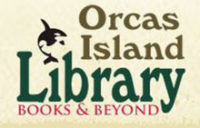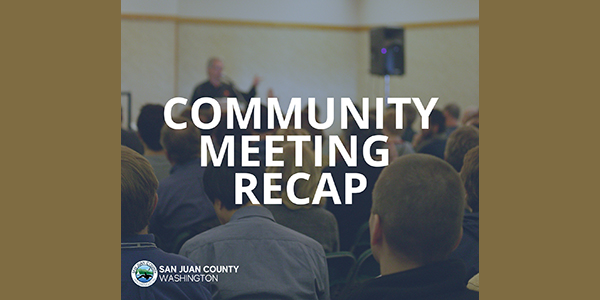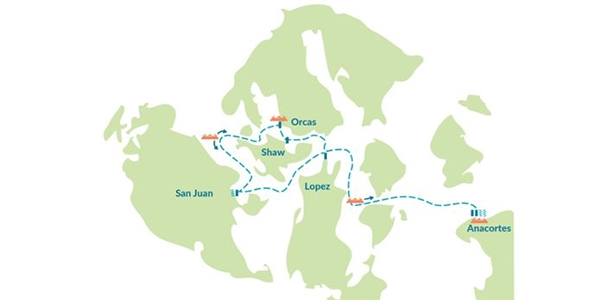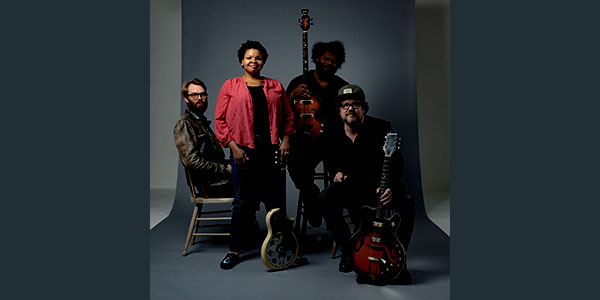
Emma Heikkinen
— by Emma Heikkinen —
REPRINTED FROM JULY 19, 2016
Let’s start in 1949, glossing over the bit where the Madrona Club hosted a small library in their clubhouse in 1909. Sally Ployart had books. Hundreds of brand new books. She didn’t know what to do with them — a three months’ collection of publishers’ copies, too much to fit on her bookshelves. Donate them to a prison? Probably not. Could have dangerous things inside. Read them all? Maybe, because it’s 1949. Create a library? Maybe, if Beatrice Cook suggests it.
Cook, author of “A Library is Born on Orcas Island,” a short memoir detailing the events surrounding the creation of the Orcas Island Public Library, entered Ployart’s living room and suggested the idea of creating a traveling library. The Sally Ployart Library, of course — what else — and shipping off the books to the lesser-served islands, islands where thirty people lounged on their patios all day in the 1949 breeze, thinking about all the books they could be reading if only a library existed.
To be clear, islanders have disputed this origin story: the Madrona Club Library had existed for years, and culture had long existed on the island before Cook came along. In their 1997 letter to the editor, Jane Walker, Madeline Haffey, and Mary Hatten asked, “why do people think Bea Cook started the first library on Orcas Island? Because she told them so. … People who write about the early history of Orcas Island should check their facts with more than one source, preferably with those who lived here prior to the 1940s.”
But history is written by the victors — in this case, Cook. Of course, Walker and company are justified in their claim of Cook’s rewriting of history. But Cook wrote a fun but disputable history of the origin of the library, and that’s what we’ve got to go on.
Back to the story: Over time, as the books completed their rounds from Waldron and Stuart to Orcas and back, novels began piling up on the shelves of the Madrona Club. This was fine for a time, but after a while the books needed more shelf space. 1952 came around, and the books moved to an old attic, then a little shack on the school grounds, then near the Outlook Inn.
The Orcas Library Association formed, lumber donated, money donated, a lot, help from Seattle, an architect named George Hazen came along. There’s more of a history there, figures and names — so many names! — plaques dedicated and girls married, but this is only the beginning and you don’t care that much, unless you’re trying to write a novel on all this. Just go read the archives, there’s 20 or so volumes.
In 1954, Mrs. Fred Meyer — owner of the Outlook Inn — donated a lot on the north side of Main Street, across the street from the historic Emmanuel Church. Summer of 1956! Beatrice Cook is sweating, the Boy Scouts are sweating, the Library Fair’s come around for the first time. A baby goat is auctioned off! We need a roof! No water! An Open House tea! Cakes! Open-faced chicken sandwiches! Friends of the Library is formed! Main Street Library opens July 1956! The card-table desk set up, the fence to keep out sheep built, and the first librarian Clydelle Chambers ushered in, Gladys Groper replacing her. Maude Louise Strayer takes over, paid fifty dollars a month.
Over the years, donations helped to replace the card-table desk with a real check-out desk and the purchase of a real clock. In 1965 and 1974, the library is expanded. Now it’s 1975, and Beatrice Cook is wrapping up her memoir. “You’ve come a long way, baby,” she finishes, with a teary celebration of volunteers and others over the years who’ve made the library a reality.
Cook’s recollections end here, and the archives tell us from 1975-1987 Library Fairs occur, dances happen, pictures taken — interesting, perhaps, but not enough to deserve a spot on the brief published chronology of the library in the newsletter from the recent groundbreaking celebration. From 1984-1988, Margaret Philbrick was the last volunteer library director.
In 1987, though, islanders voted for the Library District to become tax-supported. Hired in 1988, Victoria Parker became the first paid library director on staff. In 1989, the library decides to look into building a new facility, the precursor to the eventual move to Rose Street in 1993. After considering land on Jones Island, Madrona Point, Buck Park, and next to Orcas Center, the library made an offer on the land closest to the center of Eastsound. Although more expensive than the other options, the move was deemed best by the community and the board; staying in town in order to be an accessible community hub was worth the extra expense. Library fundraisers took place, money was raised, and eventually the $1.2 million dollar library was funded. In June 1992, construction began on the property and more than 100 islanders turned up for the groundbreaking ceremony.
On February 6, 1993, the newly constructed library held an official open house to present the library to the community. The library happily bustled along, with the building filling up and use increasing. Technology flooded the new building, as well, hitting a few snags in ten years with the need to filter pornography from users’ computers. Classes started taking place around this time, with community members streaming in in order to learn how to send emails and deal with the talking paper clip on Microsoft Word.
As time went on and visits/items/checkouts climbed, the library began feeling crowded once more — just a decade later, the staff wanted another move or expansion. The library became more active in putting on programs, as well, fulfilling more of a community role past supplying a healthy stream of literature.
2002-2003 were the years of controversy, from a proposition to increase taxes on the library which was rejected by voters, to the proposition of closing the library on Fridays in order to decrease spending. After 15 years at the helm, Victoria Parker retired in 2004, and Phil Heikkinen — coincidentally, my father — succeeded her in September of 2004.
Following 2004, funding difficulties grew with the I-747 initiative that limited tax revenues to 1% above the previous year. The Friends of the Library attempted to help the library stay afloat with regular payments every year, but difficulties continued.
Building expansion plans began in 2008 in order to fulfill the need for more space, but the Great Recession hindered the process. Pulling back, the library once more began considering expansion in 2013, again feeling pressured by the increased volume of users and lack of space. Other reasons — including the fact that for every one book received, one leaves — can be found on the library’s website, www.orcaslibrary.org
The library began developing plans and hired an architect in 2015, and received private donations, notably from the estate of Bob Henigson; alongside a State of Washington capital fund allocation, gained through the efforts of State Senator Kevin Ranker. The library raised a good amount of funds to continue with the project, and recently held the groundbreaking ceremony for the expansion.
As time goes on, the library hopes to develop with the times and continue to support the community. Current director Phil Heikkinen comments that he wishes for the library to continue to be “an intellectual hub for creative growth, a community center for development, and a prominent place of learning for years to come.”
**If you are reading theOrcasonian for free, thank your fellow islanders. If you would like to support theOrcasonian CLICK HERE to set your modestly-priced, voluntary subscription. Otherwise, no worries; we’re happy to share with you.**








Fabulous essay and history lesson about OIPL! Thanks, Emma. This is one for the archives.
Lovely writing, Emma. And very deft touch describing the library’s origins. Keep writing!
Great job, Emma.